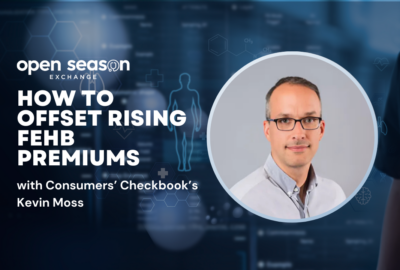2025 Open Season Exchange: OPM’s Laurie Bodenheimer on ins and outs of FEHB
Each year, FEHB enrollees will have health needs they expect, as well as surprises that can happen — both of which make Open Season all the more important.
Although Open Season is when federal health benefits are most public facing, the Office of Personnel Management works on the Federal Employees Health Benefits Program year-round.
Negotiating with FEHB carriers is a months-long process for OPM. It involves issuing call letters and determining what benefits be focused on for the upcoming plan year. For 2025, fertility benefits, maternal health and obesity medications are a few of the central focuses for the FEHB Program.
But the incoming benefits are also balanced against rising premium costs for the program. Overall, FEHB premiums are rising by an average of 13.5% for enrollees in 2025. The cost of drugs represents about one-third of the total premium, according to Laurie Bodenheimer, OPM’s associate director for healthcare and insurance.
“We know that the cost of health insurance never goes down, it always goes up,” Bodenheimer said during Federal News Network’s 2025 Open Season Exchange. “And this year, it went up a lot more than we had hoped for. But we want to try to keep those premiums affordable and reasonable at the same time.”
Each year, there is a balance of health needs enrollees can expect, as well as surprises that may happen throughout a plan year — and both are important considerations for an individual’s health care choices. More than anything, Bodenheimer urged FEHB participants to take advantage of Open Season this year.
“We can’t always anticipate coming down with a major illness or, regrettably, having some sort of accident or injury,” Bodenheimer said. “But do you have planned surgery that you know will happen in 2025? Do you hope to achieve a pregnancy and add to your family? Those kinds of things you can anticipate and that will impact your health care costs.”
Why feds should consider an FSA
Particularly with the sharp premium increase coming in plan year 2025, FEHB participants may be looking more than usual this Open Season at options for combating the rising costs.
One way current federal employees can hedge against increasing premiums is by taking advantage of the government’s flexible spending account program.
FSAFEDS is “one of the most underutilized benefits that we offer to employees,” Bodenheimer said. Each year, just about 20% of eligible feds participate in the FSAFEDS program.
“I’m always puzzled by that,” Bodenheimer said. “It is an opportunity to reduce your taxable income, which means you pay less taxes overall, and you can cover the cost of your copayments, co-insurance, deductible, or even services that aren’t covered by your FEHB plan, at considerable savings when you take into account both federal and state taxes.”
The amount individuals can contribute changes slightly each year and is regulated by the IRS. Under the cap for 2025, feds can make a maximum contribution of $3,300 to their FSAs.
But as long as feds continue re-enrolling in the program, they can also roll over a certain amount of their FSA contributions toward health care costs for the next year.
“You don’t have to be as concerned about as some people are about losing part of that election,” Bodenheimer said.
Dental and vision options for 2025
Dental and vision insurance plans are another popular option for federal employees and annuitants through the Federal Employees Dental and Vision Insurance Program.
In 2025, premiums will rise for FEDVIP dental plans by 2.97% on average, while vision plans will go up by 0.87%. Compared with rising costs in FEHB, the average premium increases for vision and dental insurance are minimal, Bodenheimer said, but it comes down to what works best for an enrollee’s specific circumstances.
“Are you fortunate enough that members of your family only need routine dental care? Or has your dentist told you recently that you’ll need a crown or some other significant dental work in the next plan year? Are you considering Lasik surgery, which would be an argument for enrolling in a vision plan?” she said. “Those are the types of things that you should consider for whether or not FEDVIP makes sense for you.”
In total, FEDVIP enrollees will be able to select from seven dental carriers offering 14 nationwide plan options for 2025. There will also be 10 nationwide vision plans available nationwide across five different carriers.
Medicare, prescription drug benefits in FEHB
In just the past of couple years, there have also been significant changes in the way Medicare is integrated into the FEHB Program. Starting in 2024, OPM allowed FEHB carriers to offer Medicare Part D Employer Group Waiver Plans, as long as they provided prescription drug benefits that are equal to or better than what the FEHB plan covers on its own.
Bodenheimer said most FEHB annuitants chose not to enroll separately in Medicare Part D, because there is now “very good” prescription drug coverage available through the FEHB Program.
“With passage of the Inflation Reduction Act, Medicare EGWP enrollees get the benefit of those protections that Medicare has now put into place, including negotiating drug pricing for a certain number of drugs beginning in 2026, insulin at no more than $35 in cost sharing and an annual out-of-pocket limit of $2,000,” Bodenheimer said. “And you still have the backstop of FEHB prescription drug coverage if there were to be any drug that that EGWP does not cover. A big example of that would be the GLP-1 drugs that Medicare currently does not cover, but the FEHB plans do.”
But because the changes around Medicare and FEHB were new for 2024, there was some confusion from annuitants who may have opted out this year. She recommended revisiting all options during Open Season, as it can help participants save on costs while maintaining access to benefits.
But ultimately, Bodenheimer said, “it’s an individual decision based on your individual circumstances.”
Resources and information for FEHB participants
For more information, FEHB enrollees can go to OPM’s website to find all the plans that are available to them in their area of service. On OPM’s website, feds can find links to all available plans and plan brochures.
Additionally, OPM offers a plan comparison tool to help participants narrow down their options. If enrollees are considering more specific changes, they may need to do a little more digging, Bodenheimer said.
“If you’re looking for specific benefits, you do have to either look at the brochure or contact the plan directly. Make sure to ask questions about a particular benefit that you’re interested in.”
Discover more articles and videos now on Federal News Network’s 2025 Open Season Exchange event page.
Copyright © 2024 Federal News Network. All rights reserved. This website is not intended for users located within the European Economic Area.
Drew Friedman is a workforce, pay and benefits reporter for Federal News Network.
Follow @dfriedmanWFED






